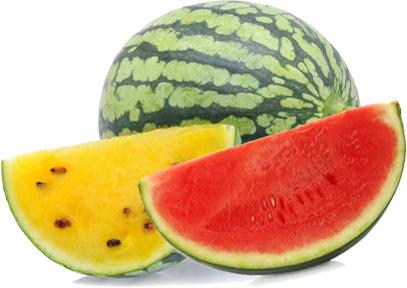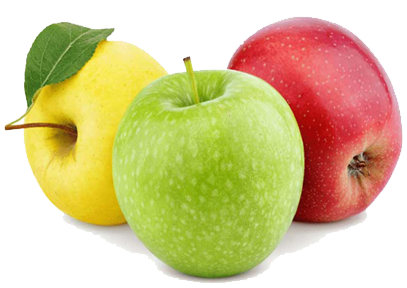
APPLE
An apple is an edible fruit produced by an apple tree (Malus domestica). Apple trees are cultivated worldwide and are the most widely grown species in the genus Malus. The tree originated in Central Asia, where its wild ancestor, Malus sieversii, is still found today. Apples have been grown for thousands of years in Asia and Europe and were brought to North America by European colonists. Apples have religious and mythological significance in many cultures, including Norse, Greek, and European Christian tradition.

PEACH & NECTARINE
Origin : Iran
Peaches and Nectarines are the same species, even though they are regarded commercially as different fruits. Nectarines have smooth skin, while peaches have fuzzy skin. The lack of skin fuzz can make nectarine skins appear more reddish than those of peaches, contributing to erroneous believe that Nectarine is a crossbreed between peaches and plums, or a “peach with a plum skin”. On average, nectarines are slightly smaller and sweeter than peaches, but with much overlap.
Refreshing and moderately in view of the energy intake, peaches fit perfectly in the summer months. They have indeed refreshing and rehydrating properties, thanks to their high water content and to their limited presence of sugars and organic acids in balanced proportions. Natural organic acids give peaches a touch of a slightly tart flavour. A nectarine is a fuzzless variety of peach.
The contribution of vitamins by peaches is very varied. The B vitamins are well represented, particularly vitamin B3 (1 mg/100 g) and pantothenic acid or Vitamin B5 (0.16 mg/100 g), as well as vitamin E (0.5 mg/100 g). One medium peach provides 8 to 10 mg of vitamin C, about 10 to 12% of the daily recommended intake.
Flavonoid pigments (prevalent in red coloured peaches) further enhance the action of vitamin C, and increase the resistance of small blood capillaries. This is a very useful effect in the summer when the sun and the heat put a strain on the circulatory system. Interestingly too is the provitamin A (or carotene) level: peaches, especially with yellow flesh, are among the fruits that provide good amounts with 0.5 mg per 100 g on average and up to 1 mg for varieties with yellow flesh. If consumed perfectly ripe, peaches are a fruit particularly well tolerated: the fibres are very tender, and act on the bowels gently and effectively. It is for this reason that very young children and even babies can eat very early poached and crushed peaches.
DETAILS.....
Refreshing and moderately in view of the energy intake, peaches fit perfectly in the summer months. They have indeed refreshing and rehydrating properties, thanks to their high water content and to their limited presence of sugars and organic acids in balanced proportions. Natural organic acids give peaches a touch of a slightly tart flavour. A nectarine is a fuzzless variety of peach.
The contribution of vitamins by peaches is very varied. The B vitamins are well represented, particularly vitamin B3 (1 mg/100 g) and pantothenic acid or Vitamin B5 (0.16 mg/100 g), as well as vitamin E (0.5 mg/100 g). One medium peach provides 8 to 10 mg of vitamin C, about 10 to 12% of the daily recommended intake.
Flavonoid pigments (prevalent in red coloured peaches) further enhance the action of vitamin C, and increase the resistance of small blood capillaries. This is a very useful effect in the summer when the sun and the heat put a strain on the circulatory system. Interestingly too is the provitamin A (or carotene) level: peaches, especially with yellow flesh, are among the fruits that provide good amounts with 0.5 mg per 100 g on average and up to 1 mg for varieties with yellow flesh. If consumed perfectly ripe, peaches are a fruit particularly well tolerated: the fibres are very tender, and act on the bowels gently and effectively. It is for this reason that very young children and even babies can eat very early poached and crushed peaches.
DETAILS.....

CHERRIES
Cherries are small stone fruits, generally averaging 2 to 4 centimeters in diameter, and have a round, oval, ovate, to cordate shape, attached to slender, pliable, and fibrous green to brown stems. The fruit’s surface is taut, smooth, glossy, and semi-thin, ranging in color from solid shades of bright red or dark red, almost black, to variegated hues of red-yellow, orange, ruby, and crimson tones. Underneath the surface, the flesh can be firm or soft, depending on the variety, and is typically aqueous, pink to red, and tender, encasing a central pit tightly adhered or loosely attached. Cherries widely range in flavor depending on the variety and sugar-acid content. Sweet Cherries generally have a balanced, sweet-tart flavor with fruity nuances. Sour Cherries contain higher acidity, contributing to tart, tangy, and unfavorable sour flavors when raw. The sharp fruits are often combined with sweeteners in cooked applications to develop even amounts of sweet and sour. In addition to the fruits, Cherry trees are often famous for their white-pink, five-petaled flowers. The delicate blossoms are highly ornamental and decorate the entire tree canopy when in bloom.

CITRUS
Citrus is a genus of flowering trees and shrubs in the rue family, Rutaceae(/ruːˈteɪsiˌaɪ/). Plants in the genus produce citrus fruits, including important crops such as oranges, lemons, grapefruits, pomelos, and limes. The genus Citrus is native to South Asia, East Asia, Southeast Asia, Melanesia, and Australia. Various citrus species have been used and domesticated by indigenous cultures in these areas since ancient times. From there its cultivation spread into Micronesia and Polynesia by the Austronesian expansion (c. 3000–1500 BCE); and to the Middle East and the Mediterranean (c. 1200 BCE) via the incense trade route, and onwards to Europe and the Americas.

KIWI
About the size of an egg, kiwifruit is wrapped in a russet-brown thin skin with short rather stiff hairs. The kaleidoscope-like almost glistening emerald green firm pulp is dotted with a large amount of dark nearly black tiny edible seeds that create this fruit's characteristic interior starburst pattern. Sometimes the flesh may be yellow, brownish or off-white. Sweet tart with a slightly acidic edge, this decorative fruit's succulent flavor is mainly sweet.
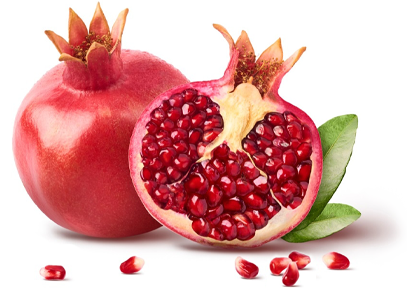
POMEGRANTE
The exterior of the pomegranate is a thick, leathery red, while cream-colored interior is studded with bright red seeds. Each tiny seed is enclosed in a translucent, red pulp. The pomegranate contains a sizable quantity of sweet-tart. The size of an apple, only the seeds and juice are edible offering a sweet-tart taste.
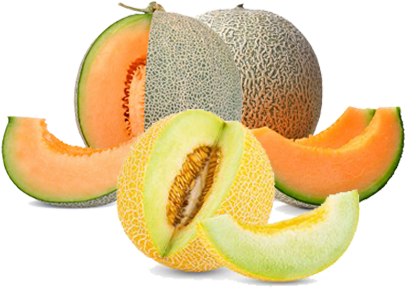
MELON
A melon is any of various plants of the family Cucurbitaceae with sweet, edible, and fleshy fruit. The word "melon" can refer to either the plant or specifically to the fruit. Botanically, a melon is a kind of berry, specifically a "pepo". The word melon derives from Latin melopepo, which is the latinization of the Greek μηλοπέπων (mēlopepōn), meaning "melon", itself a compound of μῆλον (mēlon), "apple", treefruit (of any kind)" and πέπων (pepōn), amongst others "a kind of gourd or melon". Many different cultivars have been produced, particularly of cantaloupes.
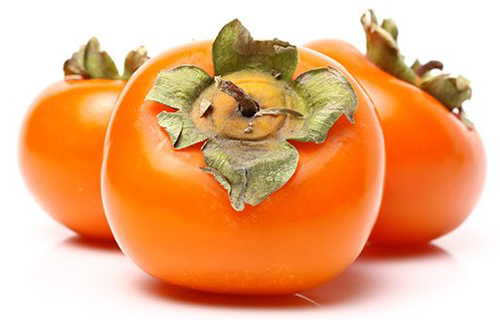
Persimmon
Harvest Season: October – March
The Persimmon has no core, is seedless, particularly sweet, and can be eaten whole. Eating the Persimmon regularly is believed to reduce the risk of developing atherosclerosis heart.
• A sweet persimmon contains twice the dietary fibre of an apple and higher levels of many minerals and antioxidants
• Persimmons are a good source of vitamin C and beta carotene
• High in fibre and fat free


